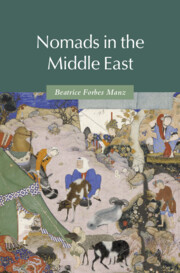Book contents
- Nomads in the Middle East
- Series page
- Nomads in the Middle East
- Copyright page
- Dedication
- Additional material
- Contents
- Figures and Maps
- Preface
- Maps
- Debate between Sheep and Grain
- 1 Introduction
- 2 Nomads in the Establishment of the Caliphate
- 3 The Rise of New Peoples and Dynasties
- 4 Turkic Tradition and Seljuqid Rule
- 5 Mongol Conquest and Rule
- 6 After the Mongols: Timurids, Turkmen and Ottomans
- 7 The Rise of Nomad Tribes,1500–1800
- 8 Nomads in the Modern Middle East
- 9 Conclusion
- Bibliography
- Index
3 - The Rise of New Peoples and Dynasties
Published online by Cambridge University Press: 12 November 2021
- Nomads in the Middle East
- Series page
- Nomads in the Middle East
- Copyright page
- Dedication
- Additional material
- Contents
- Figures and Maps
- Preface
- Maps
- Debate between Sheep and Grain
- 1 Introduction
- 2 Nomads in the Establishment of the Caliphate
- 3 The Rise of New Peoples and Dynasties
- 4 Turkic Tradition and Seljuqid Rule
- 5 Mongol Conquest and Rule
- 6 After the Mongols: Timurids, Turkmen and Ottomans
- 7 The Rise of Nomad Tribes,1500–1800
- 8 Nomads in the Modern Middle East
- 9 Conclusion
- Bibliography
- Index
Summary
This chapter follows the first three centuries of Abbasid rule. Over the first century, the Bedouin declined in prosperity and power in the army, as the Abbasids changed trade routes and brought in a new army from Khorasan. The dynasty also imported Turkic soldiers from the steppe as mounted archers; these were known as mamluks and became a major force in the caliphate. As Abbasid power declined, independent Bedouin dynasties arose. Two major factors contributed: First, the rise of the Fatimid caliphate made the desert a boundary region, allowing tribes to play off rival powers. Second, several dynasties attempted to use nomadic tribes for their own purposes, controlling them by alternating punishment and reward. By involving them in their politics and causing strife in the steppe, they strengthened tribal leadership and military power. As a result, in the eleventh century independent Bedouin dynasties controlled significant areas. The chapter also follows cultural production – the development of a literature of ethnic rivalry and characterization of three separate populations with the Arab image modeled on the Bedouin and differentiated from Persians and Turks.
Keywords
- Type
- Chapter
- Information
- Nomads in the Middle East , pp. 55 - 80Publisher: Cambridge University PressPrint publication year: 2021



